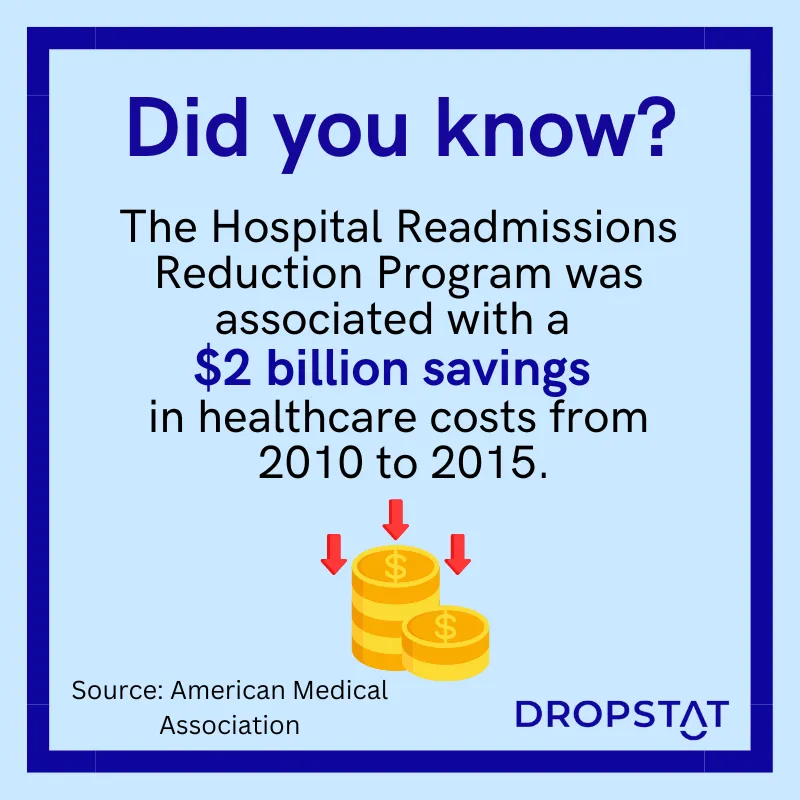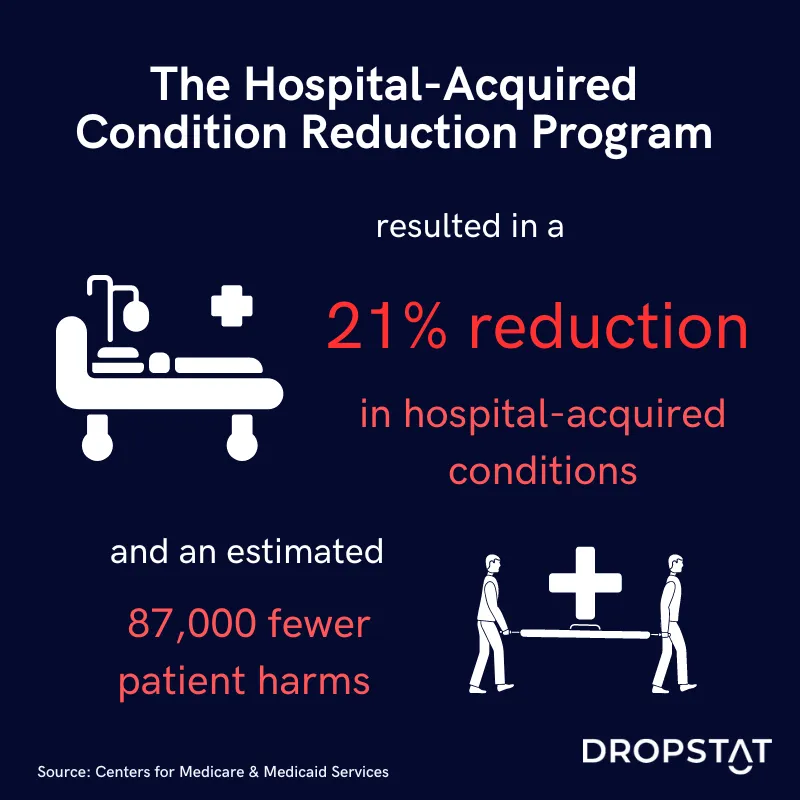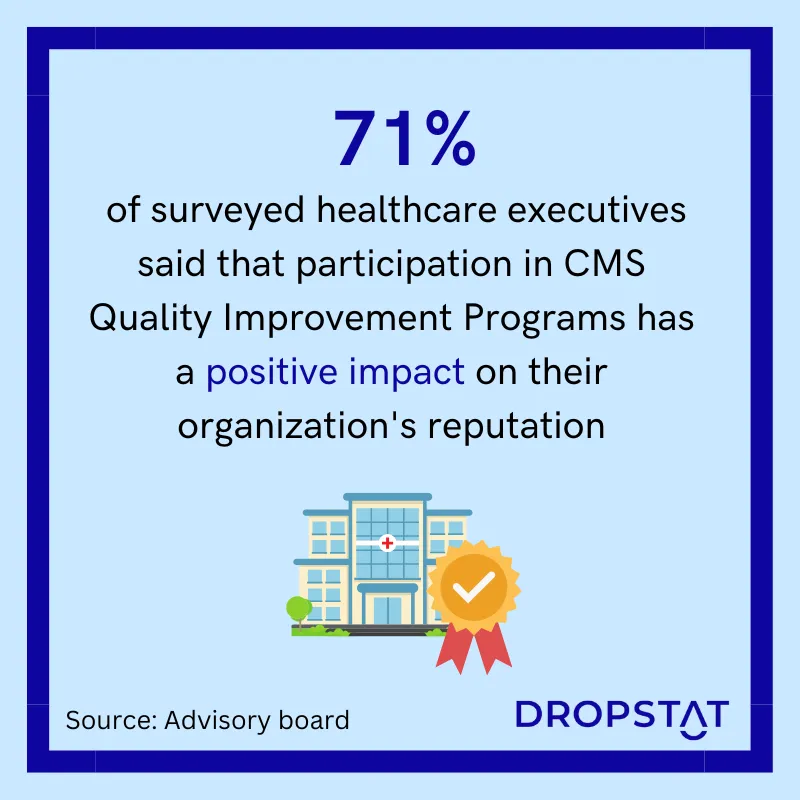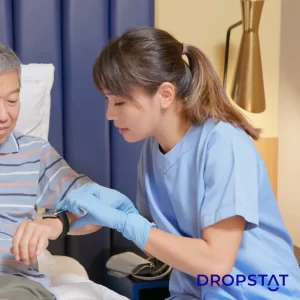Some of CMS’s main goals include:
- improving patient health outcomes
- promoting affordable care
- increasing access to healthcare
- supporting value-based care initiatives
- enhancing care coordination and provider performance
- reducing health inequities
CMS Influence on the Healthcare Industry
Given that CMS develops healthcare guidelines regarding patient safety and care quality, it is crucial that facilities ensure that their practices align with the outlined standards. Complying with the regulations grants healthcare facilities bonuses and reimbursement from CMS through prospective payment systems. However, the inability to meet these quality standards can result in penalties, including fewer reimbursements and fines, depending on the severity of the situation.
In addition, institutional reputation is a major factor associated with CMS guidelines, quality measures, and public reporting. This data enables both patients and healthcare institutions to evaluate and compare their practices to other similar healthcare facilities. Subsequently, this incentivizes providers to promote value-based care and efficient health systems which align with the CMS hospital value-based purchasing program.

CMS Quality Improvement Programs
There are multiple quality improvement programs that have been generated by CMS to alleviate the burden and cost of inadequate care and inefficient healthcare practices. The most notable CMS programs are the Hospital Value-Based Purchasing (VBP) Program as well as the Hospital Readmissions-Reduction Program (HRRP), and the Hospital-Acquired Condition Reduction Program (HACRP), which all strive to promote better care quality.
Hospital Value-Based Purchasing (VBP) Program
The purpose of the CMS Hospital Value-Based Purchasing (VBP) Program is to improve care quality by promoting increased care coordination and efficiency. Ultimately, this program acknowledges and rewards acute care hospitals through incentive payments based on care quality as opposed to the quantity of healthcare services delivered. Specifically, this program is funded by reducing the Diagnostic-Related Group (DRG) payment for the hospitals that commit to the standards of care. Some of the objectives include:
- improving patient outcomes through evidence-based care
- increasing care transparency
- improving patient experience
Hospital Readmissions Reduction Program
The Hospital Readmissions Reduction Program (HRRP) was developed under the VBP program as a method to assess care quality further and motivate hospitals to improve patient health outcomes. The HRRP program defines readmissions as “unplanned readmissions that happen within 30 days of discharge from the index (i.e., initial) admission“, or “patients who are readmitted to the same hospital, or another applicable acute care hospital for any reason.“
In order to achieve the goal of reducing readmissions nationwide, providers are required to implement more effective communication and care coordination strategies for patients and other members of the care team. This will result in more viable plans after the patient is discharged, reducing the likelihood of complications that lead to additional hospital admission.

Hospital Acquired Condition Reduction Program (HACRP)
Similar to the HRRP, the Hospital-Acquired Condition Reduction Program (HACRP) is a VBP program that strives to connect Medicare payments to the quality of care provided, rather than the quantity of services. The HACRP program reduces Medicare payments for the lowest-performing acute care inpatient hospitals and publicly reports the hospitals’ performance on these metrics. The most common infections defined by the Centers for Disease Control and Prevention as “hospital-acquired infections” include:
- Central Line-Associated Bloodstream Infections
- Catheter-Associated Urinary Tract Infections
- Surgical Site Infection for Abdominal Hysterectomy and Colon Procedures
- Methicillin-resistant Staphylococcus aureus bacteremia
- Clostridium difficile Infection
Reducing the prevalence of these infections by evaluating the Hospital-Acquired Condition (HAC) metrics provided by CMS, enables hospitals to improve their scores related to care quality and hospital-acquired conditions.
CMS Care Compare Metrics
The Medicare Care Compare website enables the public to compare doctors and clinicians, nursing homes and rehab facilities, home health services, hospice care, inpatient rehab facilities, long-term care hospital, and dialysis facilities. Through the metrics provided, facilities can obtain a better understanding of where they rank compared to other similar institutions. This incentivizes providers to deliver higher-quality and more efficient care. Some of the metrics used to determine the overall rating for hospitals include:
- patient survey rating
- timely and effective care
- complications and death
- unplanned hospital visits (including readmissions rates)
- maternal health
- psychiatric unit services
- payment and value of care
Using these metrics to compare the Ronald Regan UCLA Medical Center, and the Keck Hospital of USC, Medicare awarded both facilities 4/5 stars for the overall rating and patient survey rating. Both facilities also had similar readmission rates at 14.7% for the Ronald Regan UCLA Medical Center, and 15.5% for the Keck Hospital of USC as of April 26, 2023.
Furthermore, the data provide insight into the rate of hospital-acquired infections, such as surgical site infections from colon surgery, which were better than the national benchmark at both hospitals, indicating high-quality care and patient safety.

How Dropstat can help your facility align with CMS Value-Based Purchasing and Quality Improvement programs
Given that CMS has enacted mandates for safe nurse-patient staffing ratios, Dropstat’s data analytics allows healthcare facilities to determine shifts that are understaffed, overstaffed, and safely staffed. This insight into various shifts and nursing disciplines enables schedulers to reconfigure staff schedules in order to comply with CMS standards and improve patient safety and outcomes.
Additionally, Dropstat’s ability to calculate hours per patient day (HPPD) gives schedulers the ability to construct shift schedules that meet CMS standards well in advance. This practice reduces the likelihood of overspending on nurse overtime and agency staff, which improves operational efficiency.
Adequate staffing promotes higher care quality and coordination between all care team members while decreasing burnout and medical errors. In turn, this reduces hospital readmissions and improves patient health outcomes. Ultimately, this leads to additional CMS payments in recognition of the care as well as more advantageous public reporting through the Medicare Care Compare initiative.
Schedule a demo now to start utilizing Dropstat’s scheduling features and gap-shift management capabilities to promote safer shifts that help meet the CMS Hospital Value-based Purchasing Program.







